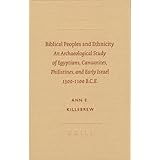
Average Reviews:

(More customer reviews)Killebrew's book attempts to sift archaeological, historical and biblical data to discover what distincitves can be known about some of the ancient people groups of the Levant, specifically the Egyptians, Canaanites, Israelites, and Philistines.
Egyptian presence in Canaan is seen as an imperial link rather than aggressive domination (total control). The author disagrees with the view that Canaanites were attempting to emulate Egyptian styles and sees cultural artifacts as evidence of Egyptian enclaves, some especially set up as administrative districts for regulation and the collection of taxes. The Philistine occupation of the Levant is understood by the author as one of intentional colonization rather than a group of invaders or migrating conquerors and much of the author's writing moves in support of that view. For the Canaanites, mostly data from composite archaeological findings is presented, including temples, burials, housing, & especially pottery. Defining the Canaanites is a struggle and so they are identified primarily by date and region. Little is said about the Transjordanian Edomites, Moabites and Ammonites in the book.
Killebrew's acceptance of the current position that Israel emerged from native Canaanites makes her identification of Israel a bit speculative. Israel is seen as a mixed people group derived from the native Canaanite population under the influence of Egyptian politics. Briefly discussed are some of the ethnic identifiers for Israel that have been suggested previously, for example, the four room house or the collared rim storage jar. The author is sensitive to the biblical story but rejects much of the biblical record as having any historical value.
The book is a bit more orientated toward ethnic interchange or cultural migration than an examination of ethnic identity. It is well documented and Killebrew supports her views with ample reference to archaeological data, especially pottery, and there is little emphasis on linguistic material. Her discussions of pottery will be perceived as a bit tedious to some but they provide helpful material in support of her points and reduce perceptions of speculation. The emphasis on pottery is an expression of the author's expertise in that area but also a reminder of how little physical evidence for a discussion of ethnicity really exists.
The book is a helpful summary of archaeological data, especially pottery, and a helpful presentation of the many issues involved in seeking the ethnicity of ancient peoples. Her presuppositions about the origins of Israel and the biblical narrative shape her conclusions about Israel.
Click Here to see more reviews about: Biblical Peoples and Ethnicity: An Archaeological Study of Egyptians, Canaanites, Philistines,... (Archaeology and Biblical Studies (Brill Academic Publishers), No. 9.)

0 comments:
Post a Comment